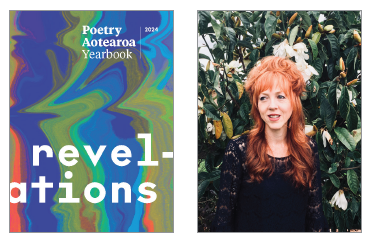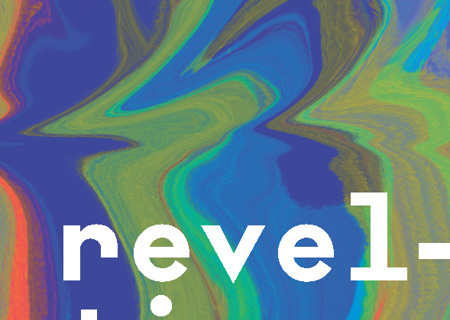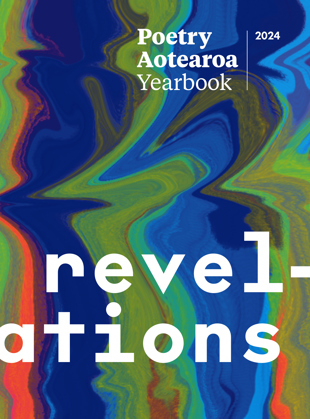
Q1: Another bumper edition of Poetry New Zealand Yearbook: 123 new poems by 102 poets. How many poems were submitted?
A jaw-dropping amount — we always tip the 1000 mark — but luckily, I had the wonderful poet Evie Howell helping me as intern this year. I owe her a huge debt for her savvy spreadsheeting. Plus, the amazing team at Massey University Press!
Q2: How do you decide which poets get more than one poem?
With the incredible influx of first-rate poems I receive from across Aotearoa, it’s been a case of one-poem per-poet for the latest issues, as I’m keen to showcase as many voices from around our country as I can. The challenge comes when some poets send me four or five pieces, all equally breathtaking! This year my favourite poets Elizabeth Morton, Jack Ross, Wes Lee and Olivia Macassey sent me an embarrassment of riches, every single poem a knockout! Making the final pick often involves putting the whole manuscript together to get a sense of how the pieces flow and speak to each other.
Q3: Your editorial is just incandescent. What tone and mood in this year’s batch was it picking up on?
The point where personal hurt meets collective oppression was set alight again and again in the poems that poured in this year, and I was powerfully struck by the way that our poets are ‘writing from the red house’, bent on witnessing patterns of wounding and the system that produces it. The level of ferocity and fight was simply unmistakable, a risk-taking driven by sheer emergency — I wrote my editorial in allegiance to it, and to commemorate voices we’ve lost.
Q4: The featured poet for the 2024 edition is Carin Smeaton. Tell us about her and her work.
Carin is a Tāmaki Makaurau poet with such vocal spark and urban edge — her speakers always hit hard and deal stinging truths, her lines electric with the bone-deep directness of their talk. She takes us ‘straight down the sternum’ of her characters, plunging us gut-level into their rhythms and stories, and breaks her lines with razor-sharp skill. I love the political kick to her work.
Q5: Where did you first come across her?
I first encountered Carin’s poems when she submitted work to Mayhem Literary Journal — I was instantly impacted by the original force of her writing, and super keen to track down her first book Tales of the Waihorotiu when it came out from Titus Press. I’m thrilled that she agreed to share this dazzling spread of fresh work with Poetry Aotearoa — and to hear that she’s got another book of poems ready too!
Q6: The review section of this year’s edition is once again comprehensive and generous. What are you aiming for here, as editor?
There is always more poetry to discover in this country, but sadly so little of it ever gets displayed or celebrated on our bookshop shelves — a review section can give poetry crucial ‘window-space’. Plus I’m a long-time lover of reviews written by those who are poets themselves — so I try to match books with reviewers who can respond at this level to their fellow-writers’ work. The result is a spread of reviews that are often as lively, dynamic, distinctive and lush as the poems!
Q7: That section shows that, once again, 2023 was a very busy year for both poets and poetry publishers. What’s going on?
Poetry is an art-form honed and ready to speak to the pressing live issues of now — the signs are everywhere in our contemporary writing. The poets are definitely charged and the surge of voices keeps coming — so it’s great to see that there are publishers, from established to indie, primed to keep them in print.
Q8: If there was an award for the most bewitchingly titled poem in this collection, to which poet would it go?
My favourite comes from featured poet Carin Smeaton's section: ‘a musical is only 10% of the revolution.’
Q9: And for the most fiendishly complex?
Although only two words Joel LeBlanc’s ‘Corpse Fauna’ delivers a complex, visceral shiver. And Freya Norris’s ‘I love you 16cm deep’ is another clever title that wields the chill of connotation.
Q10: This is Poetry Aotearoa’s fifty-eighth volume. Fifty-eight years of publication! It’s such an amazing legacy and heritage. Why is it as important now as it was in 1951, when Louis Johnson published the very first edition?
When I first took on the role of editor, I inherited boxes brimming over with copies of every past issue, Poetry Aotearoa’s history. The immensity of what this journal has accomplished really hit home as I sifted through — an incredible legacy of voices that have shaped our poetry landscape was included in those volumes. To go on creating a space that celebrates our diverse poets and sustains our poetic community is crucial — this issue is another testament to how much power our voices have when shared.


